 |
Technical improvements to enhance plug and socket safety |
general info |
| Looking
at the white porcelain socket below it will be clear that to nowadays
standards it is an unsafe model. Fortunately the socket dates back to
times that 110 Volt was the common domestic current. Touching a 110V
contact is dangerous, but usually not lethal. Touching exposed parts of
220-240V sockets, plugs or
appliance parts under tension may have far more dramatic consequences.
See Wikipedia entry 'Electrical
injury' for details. Through the years several technical improvements have been made to enhance safety of electro- technical accessories. Gradually they became mandatory in standards world wide. |
The web page focuses on technical
improvements related to domestic
single phase electricity. Three phase and heavy duty devices, meant for
industrial use, have to comply to additional safety rules. Below only one example shows a type of technical improvement, not necessarily being the earliest model. Companies in different countries may have developed improvements independent of each other, more or less at the same time. No attempt has been made to construct a kind of time line. Names of manufacturers are omitted. Meaningful improvements have been implemented by all competitive companies. |
| Classic sockets and plugs were often prone
to accidents |
| 1 |
2 | 3 |
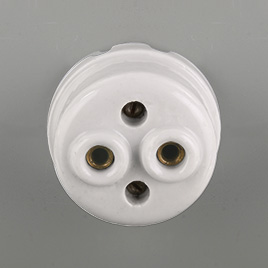 |
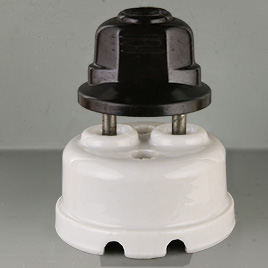 |
 |
| 1 | Porcelain socket with exposed contacts. Risk of electric
shock by touching with
finger or metal object. Improvement: safety shutters (see image 5). |
4
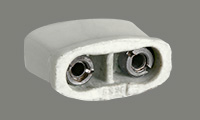 |
| 2 | Risk of electric shock by touching not fully inserted pins,
because pins are already connected to socket contact. Improvements:
recessed sockets (see image 6) and/or plugs with
insulating sleeves
(see images 8). |
|
| 3 | A plug pin of an appliance cord is connected to the line
(phase) socket contact, while the other pin is outside the
socket.
Touching the outside pin results in an electric shock. Improvement: larger socket (see image 7). |
|
| 4 | Risks
of electric shocks visualized in images 1, 2 and 3 apply to connector
plugs also. |
| Socket safety improvements |
| 5 | 6 | 7 | |
 |
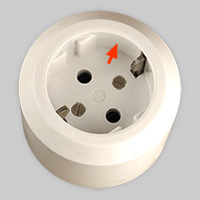 |
 |
| 5 | Socket
with safety
shutters. Plug pins have to be pressed down simultaneously to rotate
shutters away. For 3-pin plugs it is often the earth pin that shift shutters away (see for example image 12). Earth contacts don't have a shutter. Several shutter systems exists; details are given on a separate page. |
 |
| 6 | Recessed socket.
Shown is a Schuko socket with 18 mm deep recess (see also plug 11).
Sufficient safe depth depends on distance between top of socket
contacts and
surface of recess + depth of recess, in relation to plug pin length.
For example Schuko: distance to contacts 8 + 18 = 26 mm and length of
Schuko plugs is 18.5 mm. Touching pins under tension is not possible. |
|
| 7
note |
Socket with
sufficient large size to prevent insertion of a single plug pin, as
shown in image 3. Distance between center of socket contact and socket edge have to be at least 20 mm for plugs with 19 mm pin spacing. Possibility to insert a single pin still exists when using some adapter plugs. See image right >> |
| Plug safety improvements |
| 8 | 9 | 10 | |
 |
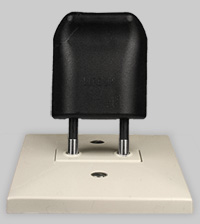 |
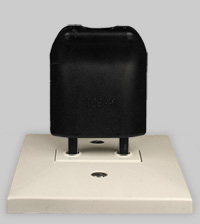 |
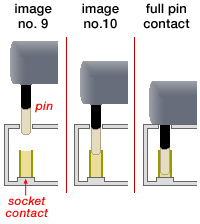 |
| 8 | Insulating pin sleeves prevent an electric shock when touching a partially inserted plug. The percentage of a plug pin that is insulated differs between plug types, but is around 50% (+/- 10%). Earth pins never have sleeves (see plug nos 12 and 13). Line and neutral pins of plugs that are used in recessed sockets usually have no sleeves. The recess offer already sufficient protection. |
| 9 | Plug
is partially inserted, but pins doesn't touch socket contacts. See
schematic drawing right. No risks when touching metal parts of pins. |
| 10 | Plug
pins are just connected to socket contacts. Only insulated parts of
pins can be touched. To power an appliance the plug has to be pressed
fully down; see scheme. The space between socket cover and top of contact is sufficiently large for safety shutters (not drawn in scheme). |
| Protective Earth Connection |
| 11 | 12 | 13 | |
 |
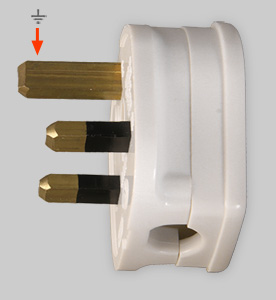 |
 |
| info |
A
damaged wire insulation may allow charge to flow along an unintended
path,
for example the metal housing of an appliance. Touching the
appliance results in a serious electric shock that may cause a deadly
cardiac arrest. The chassis of appliances that have exposed metal parts must be connected to a separate earth conductor.* The protective earth conductor is the first connection when plugged in and the last to be broken when the plug is removed. |
Images 11-13 show examples that meet the requirement. A short circuit between phase and neutral, or phase and earth is likely to result in a high current that triggers the overcurrent protection device in the meter box or blows a fuse. Low leakage currents will be discontinued by a residual current device (see nos. 23 and 24). Sources and more information: Wikipedia (1), Wikipedia (2). |
| 11 | Schuko plug with two
earth clips. Earth clip makes contact first. Image 6 shows a Schuko
socket. |
| 12 | British BS 1363
plug. Earth pin is 5 mm longer than line and neutral pins. Earth pin
pushes line and neutral shutters away and makes contact first. Note
that the cord exit is at the plug side, rather than plug top; see Cord
grip for explanation. |
| 13 | Swiss T12 domestic
plugs have three pins of equal length. Matching T13 socket earth
contact has a 5 mm advanced position compared to line and neutral
contacts which ensures that earth contact is made first. Besides Swiss also Danish domestic sockets have an advanced earth contact. |
| * note |
A protective earth connection is not required for double insulated electrical appliances that have a reinforced protective insulation in addition to basic insulation. |
 |
A square within square is the symbol for double insulated (Class II} appliances. Plugs without protective earth pin can be used safely (for example plug no. 22). |
| Connection
between socket contact and plug pin |
| 14 | 15 | 16 | 17 | 18 | |
 |
 |
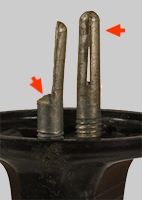 |
 |
 |
| 14 15 16 |
Initially
socket contacts were simple hollow tubes. Split pins (image 15) were used to ensure sufficient and stable plug pin contact. Using a knife or screw driver the distance between both pin halves could be adapted. However enlarging the split size resulted occasionally in breaking off a plug half (image 16, left arrow). Pressing the halves firmly together results in a too small pin diameter to make stable contact (right arrow). |
| 17, 18 | Modern
socket contacts have one or another type of flexible clips that ensures
stable pin contact and allows
the use of solid pins. Image 17 shows a contact type with a spring
keeping the clip tips together. Several more flexible clip
variants exist. Diameter of solid pins (image 18) depends on the plug rating; 4.0 mm for max. 10A, and 4.8 - 5.0 mm for 16A. |
| Cord grip |
| 19 | 20 | 21 | 22 |
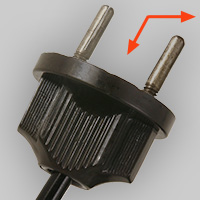 |
 |
 |
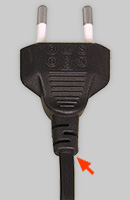 |
| A sturdy wire connection and firm
plug cord grip are essential to prevent unattended disconnected wires. |
|
| 19, 20 |
Plugs that
have been used in the first decades of the previous century often
had a rather basic and reduced reliable method to attach wires to pins.
Many of these plugs did not had an additional cord grip. Unplugging by
grabbing the cord, rather than using the plug itself, is
asking for troubles. A
modern cord type has been used to illustrate the method to attach
wires.
|
| 21 | Inner part of plug
with robust
cord grip (red arrow). Nevertheless, grabbing cords is still unwise. |
| 22 | Molded
cord; a very different type of cord grip. Plug and cord are an
inseparable unity. Often used for appliance cords with any type
of wall plug and IEC 60320 connector plug. Image shows a CEE 7/16 mains
plug (Europlug). |
| cord exit |
Most
plugs have a plug top cord exit (see no. 19), but a side exit exists
also. It can be more convenient for wall sockets (cord is hanging
down), but it is also more safe. Unplugging by grabbing a side exit
cord
is quite ineffective. For this reason it is mandatory that British
domestic plugs (BS 1363) have a cord side exit (see no. 12). |
| Residual Current Device (RCD) /
Ground Fault Circuit Interrupter (GFCI) |
| 23 | 24 |
|
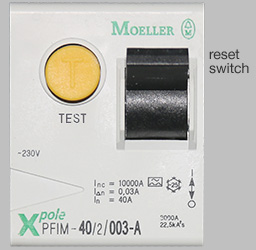 |
 |
|
| RCD info |
RCDs
are designed to disconnect the circuit if there is a leakage current.
They operate by measuring the difference between current flowing
through the live (line) conductor and that returning through the
neutral conductor. If these do not sum to zero, there is a leakage of
current to somewhere else. Somewhere might be a person touching a live component of a socket, plug or appliance causing some of the current to take a different return path (body), instead of neutral conductor. RCDs detect small leakage currents (typically 5–30 mA) and |
disconnect the circuit sufficiently quick (<30
milliseconds) to prevent a serious electric shock. A small leakage current, such as through a person, can be a serious fault, but would probably not increase the total current enough to blow a fuse or activate an overload circuit breaker to isolate the circuit, and not fast enough to save a life. Source
and more information: Wikipedia
|
| 23 |
Example of
one of the RCDs on the mains switchboard of the plug and socket
collector's home (Netherlands). Additional, compulsory, overcurrent
protection
devices are not shown. RCDs are mandatory in an increasing number of countries worldwide. |
| 24 | Dual NEMA 5-15
socket with a GFCI. In the US and Canada the name Ground Fault Circuit
Interrupter (GFCI) is used rather than RCD. In the US and Canada local electrical codes requires that GFCIs* be used in all kitchens, bathrooms, garages and outdoors. * usually a NEMA 5-15 dual socket with build-in GFCI. For outdoor use GFCI in-line portable adapter cords exist. |
| ElectroStatic Discharge (ESD) |
| 25 | 26 |
|
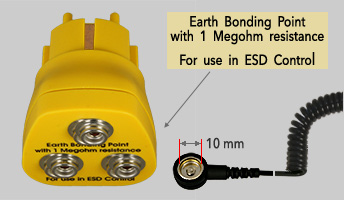 |
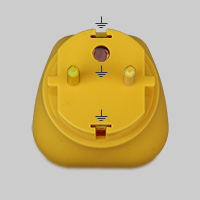 |
 |
| ESD info |
Static
electricity is an imbalance of electric charges within or on the
surface of a material. The charge remains until it can move away by an
electric current or electrical discharge. In particular semiconductor devices are very sensitive to the presence of static electricity. Antistatic straps and mats connected to ESD earthing plugs are necessary in production processes to avoid damage by static electricity. |
Earth plugs are usually connected to strap or mat
through a coiled retractable cable and 1 megohm resistor, which allows
high-voltage charges to leak through but prevents a shock hazard when
working with low-voltage parts. |
| 25 |
ESD earthing
plug with 1 megohm resistance end three 10 mm push button contacts.
Connection to antistatic strap of mat is made by a spiral cable. Other
end of cable (not shown) has either a 10 mm push button or crocodile
clip. |
| 26 | Design of the ESD earthing
plug is based on CEE 7/7 (Schuko hybrid plug), but only the earth
contacts are active, being two CEE 7/4 earth clips and a CEE 7/6
contact for 4,8 mm earth pin. |
The shown ESD plug doesn't have a manufacturer's name or logo. The spiral cable has a SG logo (see image). SG stands for Safe Guard. Probably a trade name used by the Chinese company Safety Working Tech in Shenzhen, Guangdong province. |
| |
D i g i t a l M u s e u m o f | |
P l u g s a n d S o c k e t s | |